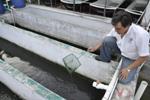 Researchers in Mexico have found that three common species of bacteria have voracious appetites for methyltestosterone (MT), a potentially harmful steroid that fish farmers use to change the sex of tilapia. The discovery may eventually result in a safer environment for farm workers and nearby residents and wildlife. It has global implications given that tilapia is raised in more than 100 countries, according to the U.N. Food and Agriculture Organization.
Researchers in Mexico have found that three common species of bacteria have voracious appetites for methyltestosterone (MT), a potentially harmful steroid that fish farmers use to change the sex of tilapia. The discovery may eventually result in a safer environment for farm workers and nearby residents and wildlife. It has global implications given that tilapia is raised in more than 100 countries, according to the U.N. Food and Agriculture Organization.
Tilapia producers add methyltestosterone to the powdered food they dish out to large tanks of tiny tilapias called fry every day for three to four weeks to turn them into males. They want males because they grow faster than females and because having only one gender prevents reproduction. (Breeding makes the farmers' operation less cost-efficient.) The young tilapias swallow the steroid but then excrete it back into the water through their feces and urine.
Fish biologist Wilfrido Contreras Sanchez worries that MT residue might endanger the health of workers who wade into the water to scoop up juvenile fish. Also, many tilapia producers discharge the hormone-laced water from the tanks into streams, rivers and lagoons where it might harm other fish and amphibians, said Contreras, who heads the biological sciences division at the Autonomous Juarez University of Tabasco where the bacterial research was conducted. Additionally, the health of local residents who swim in or wash clothes in these bodies of water might be at risk, he said.
Contreras said little is known about how the use of MT in aquaculture might affect humans or wildlife. MT is an androgen and is prescribed to stimulate puberty in slow-developing adolescent boys and to treat breast cancer. The U.S. Food and Drug Administration has said that prolonged use of high doses of androgens has been associated with the development of liver cancer and that androgens may increase elderly people's chances of developing prostate cancer. High doses in women can lead to deeper voices, facial hair, acne and irregular menstrual cycles, the FDA said.
Contreras hopes that the bacteria he studied will eliminate potential hazards if added in sufficient amounts to the water filters in the tanks where the tiny tilapias dine on MT. They're naturally present in all fish culture systems (particularly in the filters) but not in large enough quantities to degrade the hormone, he said.
In lab tests, he and fellow researchers found that Pseudomonas fluorescens, which spoils milk, and Bacillus ceresus, the culprit of food poisonings, each removed 99 percent of the hormone after 20 days in flasks. Another species, P. aeruginosa, which can cause rashes, pneumonia, bladder infections and swimmer's ear and can even break down crude oil, devoured 97 percent of the hormone after 16 days in flasks.
Because the single-celled P. aeruginosa had multiplied rapidly in the lab, researchers selected it for the next leg of the experiment. They added billions of the bacteria to filters that used gravel and special plastic balls to clean the water of three 8,000-liter concrete tanks. The filters were inside plastic drums that stood on the edge of the tanks. Each tank held 5,700 young tilapias that were fed MT daily (The fish ate the MT before it was pumped into the bacteria-smothered water filters on the other end of the tanks). The trial showed a trend toward lower levels of MT over time in the tanks where bacteria had been added versus the control tanks without bacteria, Contreras said.
Wilfrido Contreras Sanchez scoops young tilapias out of a tank where they're fed methyltestosterone to turn them into males. Located at the Autonomous Juarez University of Tabasco in Mexico, these tanks were used in a study that tested the ability of bacteria to remove the steroid from the water. Photo by Tiffany Woods.
He and his team plan to conduct more experiments to fine tune how many bacteria to use, what species or combination of species to use and how long to let them feast, Contreras said. If the kinks are worked out, the university hopes to grow mass quantities of whatever bacteria are finally selected and then sell the microorganisms to tilapia producers in the form of a concentrate, he said.
MT aside, the researchers uncovered something unexpected in their experiment. The fish in the tanks with P. aeruginosa weighed more than those in tanks without the bacteria. Some species of bacteria in aquaculture systems enhance growth, and P. aeruginosa may be one of them, Contreras said. Also, lab tests found no diseases in the kidneys, livers or spleens of fish raised in tanks with the bacteria. Because the bacteria are already ubiquitous and may be eaten by tilapias, Contreras doubts that they would cause any health problems, like infections, in people or fish.
The research was funded by Oregon State University, the University of Arizona, the Autonomous Juarez University of Tabasco, and the U.S. Agency for International Development through its AquaFish Collaborative Research Support Program.
http://eponline.com/articles/2010/10/12/bacteria-may-remove-steroid-used-in-tilapia-fish-farming-from-water.aspx?sc_lang=en
